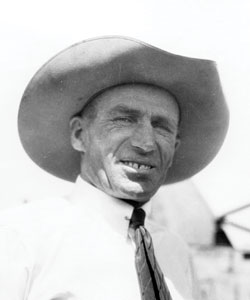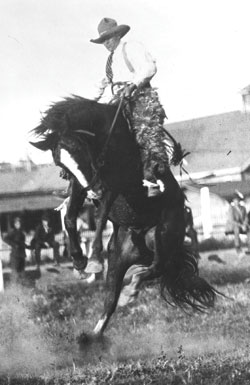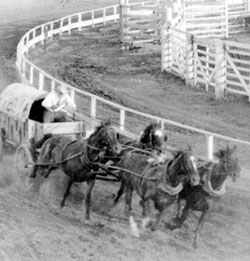
Honoured Cowboy
As the Calgary Stampede embarks on its Centennial celebration, the names and ghosts from Stampede’s past begin to resurface.
As Quaker writer William Pollard once described, “It is the responsibility of leadership to provide opportunity, and the responsibility of individuals to contribute.” Stampede founder Guy Weadick, with the assistance of the Big Four, provided the opportunity. Of all the tens of thousands of cowboys, cowgirls, horses and cattle whose contributions shaped the Stampede to what it is today, only one has ever been singled out by the Calgary Stampede.
In 1952, on the fortieth anniversary of the Stampede, an illuminated scroll was presented that read:
Presented on the occasion of the Fortieth Anniversary of the Calgary Stampede to Clem Gardner of Pirmez Creek, Alberta. Judged by the Calgary Stampede Committee to be the 1912 Contestant who has in the years from 1912 to 1952 contributed most to the growth and success of the Stampede.
Clement Gardner was born in Russell, Man., in 1885 to Captain Meopham Gardner and his wife Margaret. The following year Captain and Mrs. Gardner and their two small sons, Edward (Teddy) and baby Clem traveled west for six weeks (nearly 600 miles) by democrat buggy to homestead southwest of Calgary on Pirmez Creek, Alta. Captain Gardner called it Burgie Ranch and it was here that young Clem learned to ride, rope and handle cattle. In 1907, a special rodeo was organized for future Canadian Prime Minister, Sir Robert Borden, at Victoria Park in Calgary, and it was here that Clem competed in his first rodeo.
In 1911, Clem married Helen Hutchison and together they raised three children, Noel, Audrey and Joan. Like their father, the Gardner children grew up with a love of ranching and horses.

Photo Courtesy NB-H-16-54 Glenbow Archives; Billy Melville
In 1912 the first Calgary Stampede was held and Clem entered a number of events, including the Canadian and open Saddle Bronc and Steer Roping, as well as the Cowboy Relay Race. He placed third in both the Canadian Saddle Bronc and Canadian Steer Roping and was named the Canadian Champion All-Around Cowboy. Over the years at other rodeos, Clem won numerous trophies in roping and bronc riding.
There was no Stampede in 1913, and World War I put a hold on it again from 1914?–?1918. It wasn’t until 1919 when the next Calgary Stampede, called the “Victory Stampede” was held to celebrate the end of WWI.
Like the Stampede of 1912, Clem again entered a number of roping and riding events, including the Three-Mile Roman Standing Race. But Clem was not able to achieve the same level of success he enjoyed in the first Stampede. To add further disappointment, Clem and Texas cowboy Joe Gardner challenged each other in Steer Roping (covering five steers) and putting a personal wager of $500 on the outcome. On his first run, Clem caught his steer in good time, but for the only time in his distinguished career, Clem’s rope snapped. The break eliminated any chance of winning the wager, and the Texan pocketed the loot. There were a number of side bets made on the challenge and much more than the original $500 changed hands. For this reason, right up till the day he died, Clem was adamant that someone had sabotaged his rope.
The Stampede was not held again until 1923, and a new innovation was brought to the table by Guy Weadick?—?the chuckwagon race. The rules were simple; “cut figure eight around barrels, out through backstretch into track, run around track back to campground, unhook team from wagon, stretch fly. No less than two stakes, and make fire. First smoke declares winner.” When ranch directors were approached by the Stampede to contribute chuckwagons and horses to the proposed race, many thought the risks were too great and the whole idea was nothing short of ridiculous. Eventually Clem and five others agreed to participate, and the Stampede’s signature event was born. When the first World Championship Chuckwagon Race was run on July 9, 1923, Clem and his crew had posted the best time, but the judge disqualified him because he did not turn his wagon toward the grandstand.

Photo Courtesy NB-H-16-54 Glenbow Archives; Billy Melville
Clem and Lloyd Lewis, another original chuckwagon race participant, were the first drivers to use Thoroughbreds, now commonplace in today’s chuckwagon races. Clem competed in the chuckwagon races until 1933, and although his driving style has been described as “fearless and reckless” causing him to have more than his share of mishaps, Clem Gardner was able to win the World Championship Chuckwagon Race at the Calgary Stampede in 1931.
Clem last competed in the Calgary Stampede Rodeo in 1944 in the North American Calf Roping contest, and for many years he supplied stock for the Calgary Stampede. His ranch at Pirmez Creek housed some of the Stampede’s own bulls and bucking horses, and he would help trail the stock, some 300 head, from his ranch to the Calgary Exhibition grounds. Clem Gardner “went West” on Easter Sunday, 1963.
There is a lot more to Clem Gardner than just his career as a rodeo cowboy and chuckwagon driver at the Calgary Stampede. He was a legend in just about every aspect of his life; cowboy, horseman, rancher, polo player and family man.
As the Stampede celebrates its Centennial year, it was the leadership of Guy Weadick who provided the opportunities to cowboys like Clem Gardner whose contributions helped make the Calgary Stampede “The Greatest Outdoor Show on Earth.”












